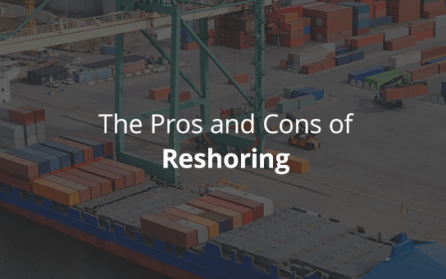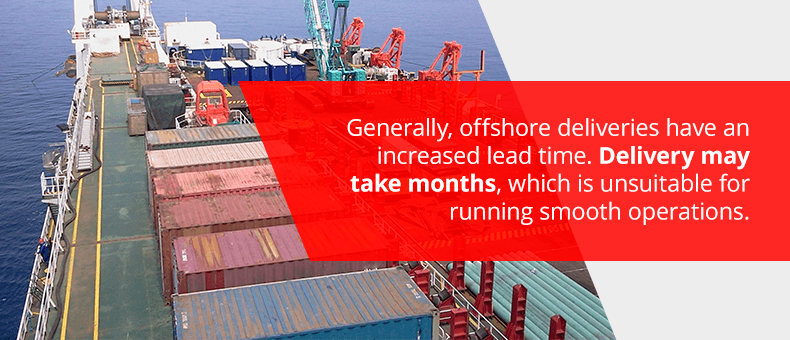Blog
The Pros and Cons of Reshoring

A few decades ago, globalization was the new terminology, and a common business strategy was physically moving factories and plants offshore in search of cheap labor and materials. Today, companies are reshoring for several reasons. This article discusses the advantages and disadvantages of reshoring and how to navigate supply chain management when restoring.
- Why Are Companies Reshoring?
- Advantages and Disadvantages of Reshoring
- What Are the Advantages of Reshoring?
- What Are the Disadvantages of Reshoring?
- How to Navigate Reshoring
- Purolator International: The Canada One Solution!
Why Are Companies Reshoring?
More companies are reshoring because of one main reason — better operational structure. We can link almost all other factors to this. Kearney’s 2021 Reshoring Index attributes the reasons for reshoring to labor availability, labor cost, delivery times and reduced carbon footprint.
Further research associates the reasons for reshoring to the instability of international trade, regulatory considerations, supply chain management and the willingness to boost the national economy.
1. Steady Labor Costs
One primary driving force behind firms moving abroad was the search for cheaper labor. However, labor costs internationally are on the rise, making reshoring a financially wise business strategy for most businesses, especially those in the manufacturing sector.
While wage inflation in offshore manufacturing countries like China is increasing, the U.S. labor cost has remained flat for the last decade. The situation is similar in Canada. This has motivated companies to consider nearshoring and reshoring options. Many countries have solid international trade policies to deal with this challenge, such as the U.S.-Mexico-Canada Agreement (USMCA).
2. More Skilled Labor Availability
Over 70% of companies reshoring cited better access to skilled labor. Most businesses require employees with technical skills for vital operations, and many of those workers are in the United States and Canada.
3. Shorter Delivery Times
Most business operations are geared toward the timely arrival of supplies. Generally, offshore deliveries have an increased lead time. Delivery may take months, which is unsuitable for running smooth operations. Reshoring helps companies improve their turnarounds, makes it easier to address concerns and simplifies the acquisition of additional stock and returns.
4. Lower Carbon Footprint
Previously, companies moved to developing countries to avoid strict laws and associated costs in their home countries. Out of a sample of 8,000 firms and 18,000 production plants, a 2017 study found a direct correlation between pollutants associated with the products and imported manufactured goods from countries with low wages.
Most American and Canadian companies today are environmentally conscious. Besides regulatory compliance concerning commercial production, industries are taking steps to reduce carbon emissions. Reshoring makes companies more accountable, and businesses understand that reducing carbon emissions has monetary and social benefits.
5. Instability of International Trade
The world has witnessed dramatic changes in international trade and politics, with China being the leading country. Beyond that, the outbreak of COVID-19 disrupted trade worldwide, making the financial markets less predictable. Although some believe stronger value chains rather than reshoring are the appropriate solution, most companies prefer to return home.
6. Regulatory Considerations
National regulations have significant impacts on business operations. Complying with quality control and material standards, intellectual rights and environmental requirements often makes overseas operations challenging. When companies reshore, they only need to follow regulations under a single framework, which is more conducive to business.
7. Willingness to Boost National Economy
Patriotism convinces most companies to take giant steps, primarily for good reasons. In 2022, reshoring data indicates that about 350,000 jobs will be created in the U.S., with a relatively slower pace in Canada. The movement expects to develop more skilled workers capable of driving the economy forward. For example, Intel broke ground to construct two new semiconductor plants in Arizona, which could cost $20 billion.
8. Improved Supply Chain Management
Supply chain management is so broad that it covers many things, but it deserves special attention. Reshoring and supply chains got a lot of press after COVID-19. Canada felt the impact in every sector, from oil and gas to mining and manufacturing. Repatriating the supply chain is one of the ways to strengthen businesses and the economy.
In today’s logistics environment, high end-to-end visibility makes it easier to identify and respond to supply chain disruptions. Years of instability in the supply chain pushed American and Canadian retail companies to shift production from China. Reshoring manufacturing operations has added benefits, including shorter lead times, increased supply chain control and reduced cost. It also helps companies deal with shortages, risks and delays.
Advantages and Disadvantages of Reshoring
Reshoring has advantages and disadvantages. While it has many benefits, understanding reshoring disadvantages will help you make the best decision for your business.
What Are the Advantages of Reshoring?
Here are some of the benefits of reshoring:
1. Improves Product Quality for Consumers
Foreign manufacturers generally rely on less expensive solutions to operate. These may include cheap labor, technologies, tools, processing operations and materials. Although cutting costs helps many businesses increase their profit margins, consumers are often left unsatisfied. Reshoring closes that gap. Industries in the U.S. and Canada must comply with quality standards centered on customer satisfaction, leadership, social responsibility, risk management, relationship management and product quality.
2. Keeps Countries Innovative and Competitive
Recently, the pace of technological growth has been exponential, with innovations such as 3D printing, artificial intelligence, the Internet of Things and blockchain leading the way. Integrated teams implement Design for Manufacture and Assembly (DFMA) software and techniques for operations. Heavily industrialized countries such as China, Japan, Korea and Singapore are competitive due to their broad manufacturing capabilities.
Reshoring brings all these innovations back home. Besides boosting global competitiveness, reshoring also fosters intrastate competition. The more companies compete against each other, the more investment they make in research and development (R&D). Basic science also contributes to green innovation with the development of better technologies. Again, research shows that an increase in the stock of patents by 1% can increase each worker’s productivity by 0.04%. The result is clear — economies founded on positive competition and innovation perform better.
3. Provides Greater Control Over Production
Companies are more efficient when they can monitor, manage and control elements such as labor, capital equipment, raw materials and land to provide services and produce goods for customers. Greater control helps them reduce costs, increase profit margins and produce quality products.
While it’s possible to manage the supply chain overseas, the task is easier and more efficient within the same region. For instance, receiving supplies and shipments nearby increases efficiency in component sourcing. Reshoring aligns the significant aspects of supply, including transportation, customs and tariffs management and deliveries.
Reshoring also closes the gap between time differences. Among other things, it makes communication simpler and more efficient. Also, regular communication and adequate information distribution are crucial for the company’s success. Reshoring makes it easy for you to relay information and receive a quick response. Well-coordinated teams deliver better results.
Additionally, the U.S. and Canada have robust laws and regulations governing the production process. This has a couple of advantages. First, products manufactured by these companies must comply with quality standards. These standards create products that are more durable and reliable. Second, companies maintain a safe working environment. Third, strict environmental protection laws reduce the impact of climate change.
4. Streamlines Logistics
Having supplies regularly in transit is one of the challenges and risks of offshoring. Once products are in transit, they’re usually considered complete. In cases of defect, the approach would be to trace the cause of the defect. Although this is an appropriate legal and operational exercise, it may not be straightforward in all instances. Additionally, the process requires labor, cost and time to execute. Reshoring reduces this challenge since products are in transit for less time.
With better oversight of operations, from manufacturing to storage and distribution, businesses can ensure their products are in good condition. Reshoring also makes managing logistics easier. For example, accessing a reliable shipping specialist in your home country that understands your business takes the load off your shoulders.
5. Creates Jobs in the Home Country
Businesses that reshore require a workforce to operate. This opens doors for both skilled and unskilled personnel. Some of the jobs reshoring create are indirect. While companies employ labor to conduct their operations, other ancillary jobs are also established. For instance, some businesses may outsource distribution and retail to other entities. Those companies, in turn, employ people to handle those operations.
Additionally, reshoring creates an avenue for teaching and learning. It serves as a platform to expand the knowledge in robotics and artificial intelligence, 3D printing, blockchain technology and other relevant innovations that drive economic growth today.
6. Offers Government Incentives for Reshoring Companies
Reshoring from China and other countries helps you avoid penalty tariffs. Many municipalities offer tax abatements, grants and other incentives to attract manufacturers back home. For original equipment manufacturers (OEMs), the incentives cut across various areas such as reshoring tax, R&D, expansion and hiring, property tax and specialized tax incentives.
For example, in the United States, OEMs can take advantage of Section 199 of the Internal Revenue Code, which allows domestic production deductions. You can take the deduction annually with IRS Form 8903. Section 41 of the Code also allows manufacturers to deduct expenditure on R&D activities that focus on improving products.
Similarly, the Industrial Research Assistance Association Programme (IRAP) helps businesses accelerate their innovation capacity in Canada. Additionally, the Scientific Research and Experimental Development (SR&ED) tax incentives offer over 20,000 claimants more than $3 billion yearly.
7. Provides an Opportunity to Build Smart Factories
Reshoring allows you to upgrade to smart factory infrastructure, whether you choose to build your facility from scratch or upgrade an existing facility. Building automated, digital factories with smart capabilities improves manufacturing and supply chain performance. This is an essential consideration for companies looking to return home. According to Deloitte Insights, companies that implement smart capabilities see a 10% increase in production, a 12% increase in labor productivity and an 11% increase in capacity utilization.
What Are the Disadvantages of Reshoring?
Companies reshoring to the U.S. and Canada may face some challenges. Here are the primary disadvantages of reshoring:
1. Starting From Scratch
Completing a U-turn after moving your manufacturing base is not a simple task. You’ll need to hire new personnel, set up new factories and plants and conduct research so you’re ready to move back home. This will likely cost your company time and money, and you many lose employees with valuable experience.
2. Disrupting Your Supply Chain
Businesses gain experience during their years of operation, developing new patterns as they make operational errors and gaining better insight into conducting their affairs. Although reshoring may disrupt the supply chain for some time, much of the experience you gain is transferable. Additionally, reshoring allows you to develop and implement the best supply chain practices that your company may not have considered previously.
How to Navigate Reshoring
Reshoring comes with some challenges but generally is more advantageous than remaining offshore. The most critical aspect is handling your supply chain. To help make the journey smoother, follow these guidelines:
- Identify offshore supply chain: While you can manage significant parts of your supply chain locally, you’ll want to consider those areas where offshore suppliers will be helpful. Categorize them into tiers to assess which is most needed. This will give you a clear idea of how to conduct your shipments.
- Contact previous suppliers: Most companies have worked with their suppliers for years. Stay with your trusted and most beneficial suppliers until you find a better alternative locally. When choosing new suppliers, consider those in accessible and friendly regions.
- Develop new operational plans: Gather the sales and operations planning team and develop operational plans for the future. While previous ideas may succeed, research new approaches that suit the region and the company’s goals. Use data analytics to guide you in the decision-making process.
- Stick to new operational strategy: Next, apply the new and improved operating system for the “new” business. This is an opportunity to test the new ideas and amend them where necessary to create a robust plan. Set clear long- and short-term strategies and ensure the entire business unit is in sync with them.
- Secure the best shipping specialist: Arguably, shipping is the center of every business operation, so it’s crucial to select a reliable specialist with regional experience. Your shipping company must have an extensive logistics network to meet your business needs.
Purolator International: The Canada One Solution!
Many companies are reshoring due to the numerous benefits associated with it. Reshoring gives manufacturers better control over their supply chain, improves product quality, enhances innovation and competition, creates jobs, offers several incentives and streamlines logistics.
Purolator International delivers a comprehensive set of logistics and shipment services to clients, including customs routing solutions, with an extensive network and reach throughout Canada and the U.S. We offer custom solutions for businesses at competitive prices. Do you want to learn more about our services? Contact us today!



